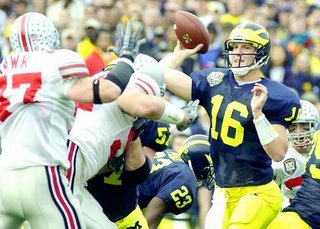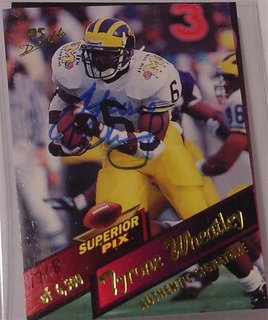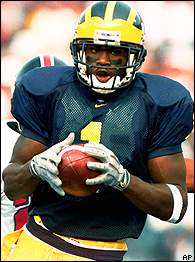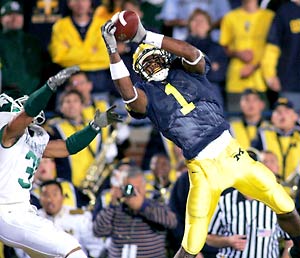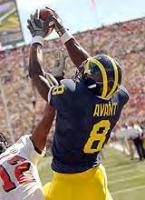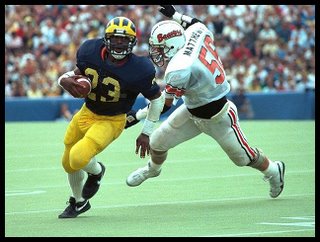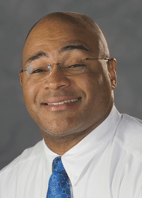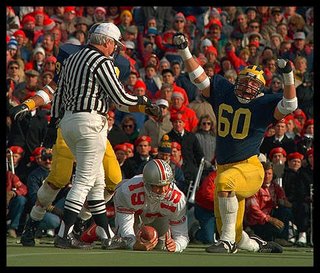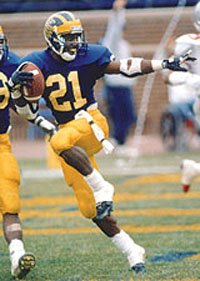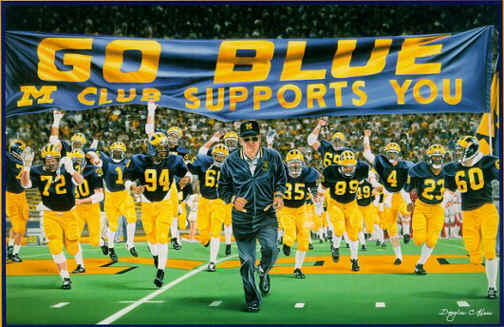Lloyd Carr is entering his 12th season as Michigan's Head Coach and he has a new Offensive Coordinator for the FIFTH time. That is a lot of turnover (pardon the pun). Although this is the fifth time time that Michigan will have a new Offensive Coordinator it is only the 4th different person to hold the job as
Lloyd has gone back to the well and re-installed his old friend
Mike DeBord as the "new" Offensive Coordinator.
DeBord previously held the post from 1997-1999 before leaving to become the Head Coach at Central Michigan from 2000-2003 where he posted a not-so-stellar 12-34 record. Michigan fans are hoping, once again, that a change of coordinators will bring new ideas to an offense that has long been incredibly predictable.
I find it interesting that while there has been almost constant upheavel on the offensive side of the ball that things have been comparatively steady on the defensive side of the ball prior to this season. Former Defensive Coordinator
Jim Herrmann held his post from 12-17-96 (his first game as Def. Coord. was the Jan. 1, 1997, Outback Bowl vs. Alabama) until the off-season following the conclusion of the 2005 campaign. Thus, while Offensive Coordinators were coming and going,
Herrmann was a constant on the defensive side of the ball. However, following last year's 7-5 season,
Lloyd decided to bring in a new Defensive Coordinator as well. I hope that
Ron English is able to establish himself and have a long run
so that Michigan has stablilty at least on one side of the ball. I'm afraid that that a return of
DeBord as the Offensive Coordinator may not be the answer to solve the Wolverines problems of lack of imagination in their offense and the Offensive Coordinator merry-go-round may not be done spinning yet. Here is a recap of the Offensive Coordinators under
Lloyd. Hold on tight so that you do not get sick from all the spinning:
Fred Jackson (1995 & 1996):  Coach Jackson
Coach Jackson served as
Lloyd's Offensive Coordinator for
Coach Carr's first two seasons as Head Coach.
Coach Jackson had been on the Michigan staff since 1992 in the capacity as the Running Backs Coach when
Lloyd tapped him to run the entire offense.
Lloyd had seen enough after two seasons and made the decision to replace him as Offensive Coordinator. However, not wanting the move to appear as a demotion,
Lloyd named
Coach Jackson as his Assistant Head Football Coach in 1997. (Note:
Coach Jackson has since been elevated to Associate Head Football Coach in 2003 which is his current title).
Mike DeBord (1997-1999): Coach DeBord's first

stint as Offensive Coordinator started off with a bang as Michigan won the National Championship in his first year. Michigan won each of the three bowl games it played in (including the 1998 Rose Bowl) while
DeBord was the Offensive Coordinator. As previously noted,
DeBord left after three years to take the head coaching job at Central Michigan where his teams struggled. He returned to the coaching staff prior to the 2004 season replacing
Jim Boccher on the staff.
DeBord has been the special teams coach/recruiting coordinator for the past two years prior to being named by
Lloyd to resume his duties as Offensive Coordinator. Will lightning strike twice with Michigan winning another National Championship in
DeBord's first season back as Offensive Coordinator?
Stan Parrish (2000 & 2001): Coach Parrish
was the Quarterbacks Coach for six years (1996-2001) at Michigan including the national championship season of 1997. He was elevated to Offensive Coordinator upon
DeBord's departure but the team only went 17-7 during
Parrish's two years at the offensive helm. That was enough for
Lloyd and
Parrish was out.
Parrish is now serving as the Offensive Coordinator/Quarterbacks Coach for 2006 Michigan opponent Ball State University which has another former U of M assistant (
Brady Hoke) as its Head Coach.
Terry Malone (2002-2005): Coach Malone 
had the longest tenure of any of
Lloyd's Offensive Coordinators by coaching (surviving) for four seasons.
Coach Malone joined the staff in 1997 as the Offensive Line coach. In 2002, he became the Offensive Coordinator/Tight Ends coach which are the titles he held until a few months ago when
Lloyd informed him that it was time to explore other coaching opportunities.
Malone landed in the NFL as the New Orleans Saints Tight Ends coach. While at Michigan,
Malone's offense was ranked #2 in the Big 10 and #24 in the NCAA in scoring in 2004 by averaging over 30 points per game. Nevertheless, perceived coaching blunders during crucial moments at the end of games doomed
Malone's return for a fifth season as Offensive Coordinator.
Hopefully, the recent Coordinator shake-up will produce the same results that occurred when new coordinators (
DeBord on offense and
Herrmann on defense) assumed their respective roles in 1997 for their first full seasons at the respective helms: a National Championship. Go Blue!
Labels: Fred Jackson, Mike DeBord




